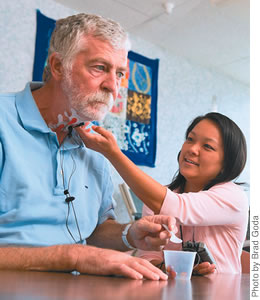
Advancing Swallowing Potential
November 28, 2007
By


Susan Fujita
Therapy Services Manager, Rehabilitation Hospital of the Pacific
What do you do as therapy services manager?
I oversee the administrative and clinical operations of REHAB’s Inpatient Therapy Department, which comprises more than 70 staff including physical and occupational therapists, speech-language pathologists (SLP), a recreation therapist, REHAB techs and therapy schedulers. My current position does not involve direct patient care. However, prior to this position, I was employed as a staff speech-language pathologist at REHAB for 14 years.
{embed=“elements/box_ad”}
As a speech-language pathologist, what was your area of specialty?
My specialty areas had been in dysphagia (swallowing disorders) and traumatic brain injury (TBI). I especially enjoyed working with patients presenting with severe dysphagia because of the gratification in helping many of them advance from tube feeding to oral diets.
What causes dysphagia?
Dysphagia is a swallowing disorder that results from any condition that weakens or damages the muscles and nerves used for swallowing (i.e. strokes, Parkinson’s disease, traumatic brain injuries, tumors, head and neck cancers). Behavioral and cognitive impairments may also compromise one’s ability to swallow safely, as with patients who have dementia or Alzheimer’s disease.
What are the signs and symptoms of dysphagia?
Signs of dysphagia may include frequent throat clearing, coughing or choking before/during/after meals, pain when swallowing, food remaining in the throat after swallowing, or nasal regurgitation (food or liquids exiting the nose after swallowing). If any of these signs occur consistently, one should contact their physician immediately.

|
What types of therapy services are available for patients with dysphagia?
At REHAB, the speech-language pathologist evaluates patients who either present with or are at risk for dysphagia. The type of treatment provided would depend on the type of dysphagia noted on assessment. Conventional therapy focuses on lip/tongue/neck exercises to improve strength and coordination of the swallowing muscles, as well as compensatory strategies such as head/neck positioning techniques. Diet modifications may be made to enable patients to tolerate a safer oral diet.
{embed=“elements/google_ad336x280”}
At REHAB, our SLPs use both conventional and state of the art techniques to advance a patient’s swallowing potential. One staff is certified in deep pharyngeal neural stimulation (DPNS), a treatment that restores strength in the muscles of swallowing and the reflexes within the pharynx. The majority of our staff SLPs are certified in Vital-Stim, a neuromuscular electrical stimulation (NMES) device which activates the muscles of swallowing via stimulation of the intact peripheral motor nerves. Vital-Stim, in conjunction with conventional therapy, has recently enabled several patients to progress from non-oral diets to near normal consistencies, which is remarkable. As a licensed massage therapist, I also learned many techniques (such as myofascial release, craniosacral therapy) and applied them to patients with dysphagia with positive outcomes.
When would a patient require tube feeding, and what types are there?
If the SLP determines that a patient is deemed to be at high risk for aspiration (i.e. food/liquids entering the throat), tube feeding would be the recommended mode of nutritional support. This would enable the patient to safely meet daily nutritional needs (including medications). The physician would determine the type of tube feeding most appropriate for the patient based on information provided by the SLP. For short-term usage, nasogastric (NG) tubes are typically recommended. These tubes pass through the nose into the stomach. If long-term usage is anticipated, surgically inserted feeding tubes may be recommended, such as gastrointestinal tubes, jejunostomy tubes and/or percutaneous endoscopic gastostomy (PEG) tubes.